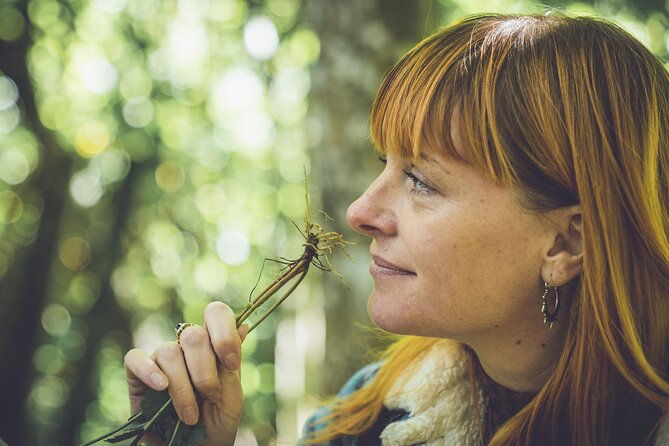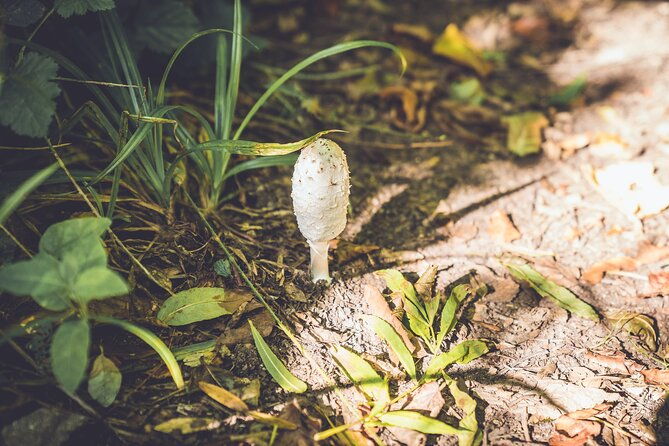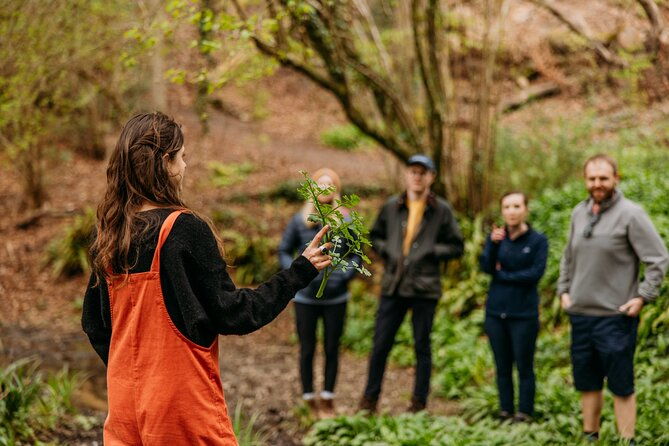Llangollen’s lush landscapes provide the perfect backdrop for exploring the art of foraging. Under the guidance of experienced experts, visitors can embark on a journey to uncover the region’s diverse array of edible plants. From identifying common greens like nettles and dandelions to understanding sustainable harvesting techniques, this hands-on experience promises to unveil the unique flavors of the Welsh countryside. With a focus on preparing foraged ingredients, the adventure offers a chance to appreciate the health and environmental benefits of this ancient practice.
Key Points

- Explore the diverse, picturesque landscape of Llangollen, characterized by rolling hills, lush meadows, and winding streams.
- Learn to identify common edible plants like nettle, dandelion, chickweed, and wild garlic, as well as mushrooms like puffball and chanterelle.
- Understand the importance of plant identification and awareness of toxic plants for safe foraging in the Welsh countryside.
- Discover sustainable foraging practices, including selective harvesting, rotational foraging, and minimal disturbance to the environment.
- Gain hands-on experience in preparing foraged ingredients, enhancing appreciation for the unique flavors of wild plants.
Exploring the Llangollen Landscape

As travelers embark on the foraging experience in Llangollen, they are introduced to the diverse and picturesque landscape that surrounds the town.
Rolling hills, lush meadows, and winding streams characterize the terrain, offering a scenic backdrop for the foraging adventure.
Participants will navigate gentle slopes and traverse well-maintained trails, allowing them to enjoy the natural beauty of the region.
The guided walk provides opportunities to observe the local flora and fauna, gaining insights into the edible and medicinal plants that thrive in this unique Welsh environment.
Looking for more options in Wales? We've reviewed plenty of other experiences.
Foraging Basics: What to Look For
What exactly does one look for when foraging in the Llangollen landscape? Foragers in this region typically search for edible wild plants, mushrooms, and berries. Some common finds include nettle, dandelion, chickweed, and wild garlic. Mushrooms like the puffball and chanterelle can also be safely foraged. A good forager knows how to identify these items and where to find them. The following table outlines some key plants, their distinguishing features, and their edible parts:
| Plant | Identifiable Features | Edible Parts |
|---|---|---|
| Nettle | Distinctive green leaves with serrated edges and stems covered in tiny stinging hairs | Leaves, young shoots |
| Dandelion | Bright yellow flower heads, green leaves with jagged edges | Leaves, flowers, roots |
| Chickweed | Small white flowers, oval-shaped green leaves | Leaves, stems |
| Wild Garlic | White flowers that resemble onions, long slender leaves with a distinct garlic aroma | Leaves, flowers, bulbs |
Identifying Edible Plants in the Wild

Identifying edible plants in the wild requires a keen eye and a deep understanding of the local flora.
Participants on the Llangollen foraging walk will learn to recognize common edible plants like dandelions, stinging nettles, and chickweed. An expert guide will point out the distinguishing features of each plant and explain how to harvest them safely.
Foragers must also know which plants to avoid, as some local species can be toxic if consumed.
With the right knowledge, the Welsh countryside becomes a bountiful natural larder waiting to be explored and appreciated.
Harvesting Techniques and Sustainability
Sustainable foraging practices are essential when harvesting wild edibles. Participants learn to identify and gather plants with care, ensuring the long-term health of the ecosystem. The instructor emphasizes minimal impact, teaching techniques like cutting leaves instead of uprooting plants. A table outlines responsible foraging:
| Principle | Actions |
|---|---|
| Selective Harvesting | Take only what is needed, leave the rest |
| Rotational Foraging | Revisit areas on a cycle, allowing regrowth |
| Plant Preservation | Avoid damaging the root system or entire plant |
| Habitat Protection | Tread lightly, don’t disturb soil or wildlife |
Preparing Foraged Ingredients
After foraging for wild edibles, participants learn how to prepare the foraged ingredients. The guide demonstrates various techniques, including cleaning, washing, and trimming the plants.
Participants may learn to identify which parts are edible and how to properly handle and store the foraged goods. The guide also shares recipes and preparation methods that highlight the unique flavors of the local flora.
Participants have the opportunity to try their hand at preparing the foraged ingredients, gaining hands-on experience and a deeper appreciation for the culinary potential of wild plants.
The session equips participants with the knowledge to safely enjoy their foraged finds.
Foraging’s Health and Environmental Benefits
Foraging for wild edibles can provide a myriad of health benefits, as the plants often contain higher concentrations of essential vitamins, minerals, and antioxidants compared to their commercially grown counterparts.
Plus, foraging promotes physical activity and reduces one’s carbon footprint by minimizing the need for transportation and packaging associated with store-bought produce.
From an environmental perspective, responsible foraging can support biodiversity and ecosystem health by encouraging the preservation of wild plant populations.
What to Expect on the Guided Walk
Typically, the guided foraging walk in Llangollen begins with an introduction to the local flora and fauna. The expert guide shares knowledge about edible and medicinal plants found in the area.
Participants learn identification techniques and foraging best practices. The group then sets out on a 2.5-hour trek through the scenic Welsh countryside.
Along the way, the guide points out harvestable plants and teaches proper harvesting methods. Participants get hands-on experience gathering wild foods.
The walk ends back at the starting point, where the group has an opportunity to taste the fresh foraged goods.
Booking and Practical Information
The Llangollen foraging experience is bookable through Viator and Tripadvisor, with prices starting from $51.21 per person.
It offers free cancellation up to 24 hours before the start of the 2.5-hour guided walk. Participants can reserve now and pay later, providing flexibility.
The meeting point is located at 9C4RXRCH+QW7 in Llangollen, UK, and the activity ends back at the same location.
The experience is wheelchair and stroller accessible, and service animals are allowed. The surfaces are wheelchair-friendly, and most travelers can participate.
Public transportation is available near the meeting point.
Frequently Asked Questions
Can I Bring My Own Food and Drinks on the Tour?
Participants are welcome to bring their own food and drinks on the tour. However, it is important to note that the tour does not provide any meals or refreshments, so guests should come prepared with their own provisions.
Is There a Minimum Age Requirement for Participants?
The activity overview does not specify a minimum age requirement for participants. The tour is suitable for most travelers, though parents with young children may want to consider the accessibility details to ensure a comfortable experience for their family.
Are There Any Dietary Restrictions or Allergies to Consider?
Based on the available information, there are no specific dietary restrictions or allergies mentioned. However, participants are advised to inform the tour provider of any dietary needs or allergies prior to the activity to ensure accommodations can be made.
What Is the Typical Group Size for the Foraging Walk?
The activity has a maximum group size of 12 travelers. The foraging walk is a guided experience with a small group to allow for personalized attention and an intimate exploration of the local forage.
Can I Extend the Duration of the Guided Walk?
The guided walk has a set duration of 2.5 hours. It is not possible to extend the duration beyond this time. The group size is limited to a maximum of 12 travelers for this experience.
The Sum Up
The guided foraging experience in Llangollen allows participants to connect with the natural landscape, learn to identify edible plants, and master sustainable harvesting techniques. This immersive excursion not only provides the opportunity to savor the unique flavors of the Welsh countryside, but also fosters a deeper appreciation for the importance of preserving the local ecosystem. Participants leave with enhanced foraging skills and a newfound respect for the bounty of the natural world.
More Tour Reviews in Wales
Still browsing? Here are more Wales experiences we've covered recently
- You’ll Love These 9 Tours & Experiences In Wales
- North Wales: GreenWood Family Park Entry Ticket
- Monmouth: Silver Circle Distillery Tour with Gin Tasting
- South Wales: Cwmcarn Scenic Drive E-Bike Tour
- City Sightseeing Llandudno Hop-On Hop-Off Bus Tour
- Full-day Best of Snowdonia Day Tour
- Two Hours Gorge Walking Activity
- Whitewater River Tubing Llangollen
- Canyoning in Snowdonia
- Snowdon Sunrise Hike
- St Davids Comedy Walking Tour
- Private Day Tour of South Wales, including Cardiff & Caerphilly Castle.
